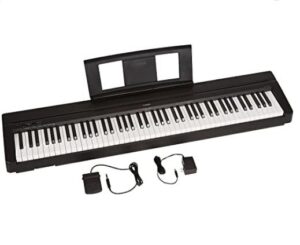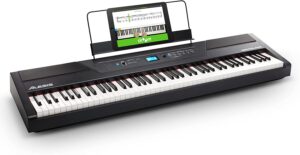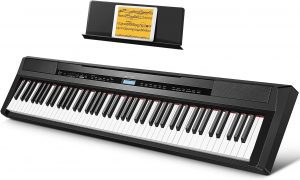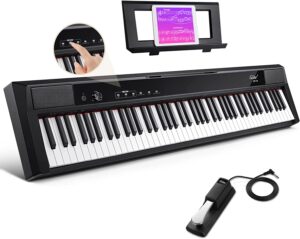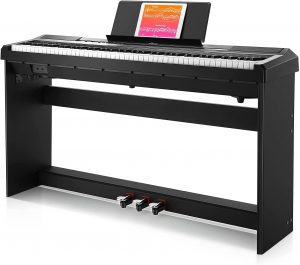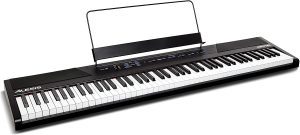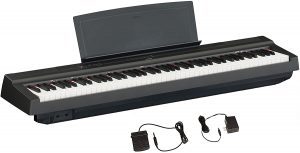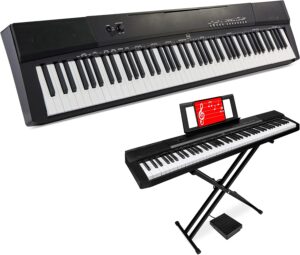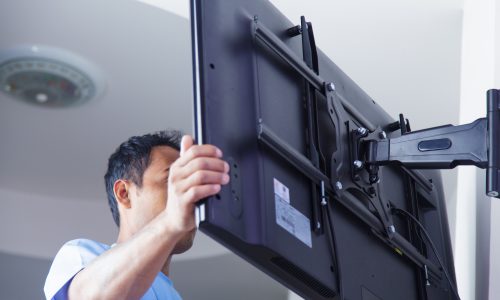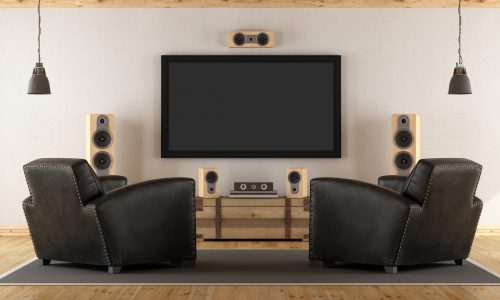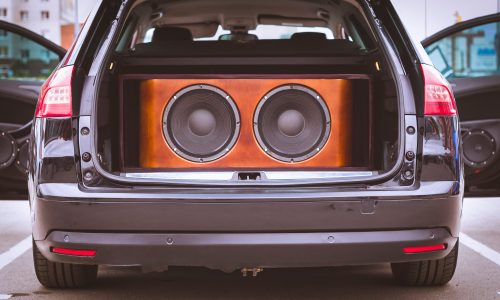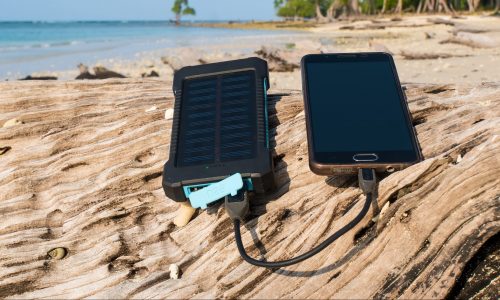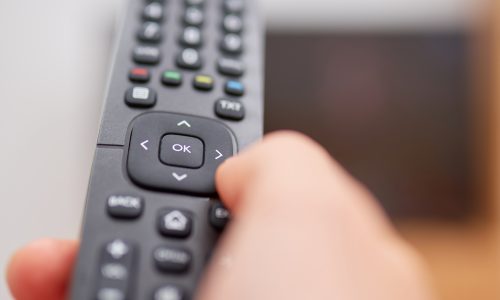The Best Weighted Keyboard Piano
We looked at the top 8 Weighted Keyboard Pianos and dug through the reviews from 23 of the most popular review sites including and more. The result is a ranking of the best Weighted Keyboard Pianos.
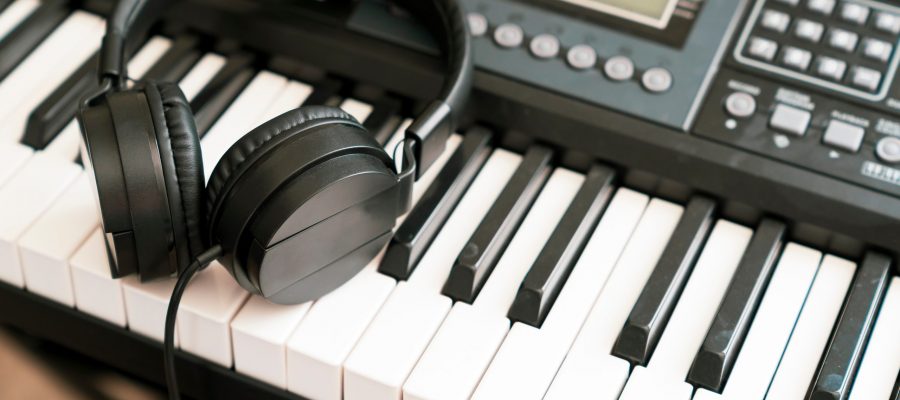
Our Review Process
Don't Waste Your Money is focused on helping you make the best purchasing decision. Our team of experts spends hundreds of hours analyzing, testing, and researching products so you don't have to. Learn more.
Our Picks For The Top Weighted Keyboard Pianos
- 1. Yamaha P71 Compact Lightweight Weighted Keyboard Piano
- 2. Alesis Recital Pro Educational Weighted Keyboard Piano
- 3. Donner DEP-20 Adjustable Touch Response Weighted Keyboard Piano
- 4. Donner DEP-10 Stand & 3 Sustain Pedals Weighted Keyboard Piano
- 5. Eastar Portable All-Levels Weighted Keyboard Piano
- 6. Alesis Recital Built-In 20W Speakers Weighted Keyboard Piano
- 7. Yamaha P125 Graded Hammer Standard Weighted Keyboard Piano
- 8. Best Choice Products Compact Folding Stand Weighted Keyboard Piano
This weighted keyboard piano offers a quality playing experience and deep, rich sound — and feels like an acoustic piano. It features 10 different premium voices and dual modes. The piano is slim and stylish, too.
Quality ExperienceThis weighted keyboard piano feels authentic and provides a good playing experience, plus rich sound.
This professionally-designed weighted keyboard piano weighs just 26 pounds, making it easy to transport to a student's home for lessons. The keyboard dazzles with 88 weighted keys, 12 premium sounds and several specialty modes, such as record and lesson modes. You can power the instrument using either a power adapter or a set of D batteries.
Excellent Teaching ToolThis weighted keyboard piano is also available with headphones and a sustain pedal.
This weighted keyboard piano is multi-purpose and can be used for rehearsing and performing as well as learning and creating. It features 238 tones, 128 polyphony and dual tone mode to combine two voices together.
Multi-Purpose OptionYou can rehearse, learn, create and perform on this keyboard that's great for beginners as well as experts.
This weighted keyboard piano is easy to operate and even comes with a touchscreen interface. The instrument features 88 fully weighted keys that are constructed from a durable ABS plastic. You'll also find this model offers dual headphone capabilities, which makes it an excellent choice for anyone giving piano lessons.
Economical OptionWhen shopping on a budget, grab this affordably priced weighted keyboard piano.
Buying Guide
The design of an acoustic piano includes hammers and strings, and when a hammer strikes the strings, they vibrate. This is what makes the full, deep sound we associate with an acoustic piano. If you want your keyboard to sound just like an acoustic piano, you need a weighted keyboard piano.
In order to recreate this type of sound and feel in a digital keyboard, manufacturers must replicate the feel of the hammer hitting the strings. If you hit the keys hard when playing an acoustic piano, the sound is louder than when you tap them softly. The weight and resistance that affect the piano strings when they connect with the lever system of the piano keys create the difference.
With a weighted keyboard piano, there are no hammers or strings, just a computer and keys that produce samples — pre-recorded audio of the way an instrument sounds, which is upgraded by physical modeling that enhances the sound and makes it more natural. The computer can detect how hard or soft you hit the keys to create the right kind of sound. However, some pianos also have weights built into the keys which help create the same feel and sound as you get with an acoustic piano.
Weighted keyboard pianos create a realistic resistance, making it easier for pianists to transition from an acoustic piano to a digital one and back again. In addition to mimicking the sound and feel of an acoustic piano, weighted keyboards also help pianists work on their finger strength and technique.
There three different types of weighted keyboard keys. Semi-weighted keys offer more resistance than an unweighted keyboard and offer a responsive playing experience. Hammer-action keyboards actually have a lever mechanism to replicate the hammer hitting the strings in an acoustic piano. Graded, weighted keyboards offer more resistance in the lower range and less resistance in the upper range, similar to an acoustic piano.
Why we recommend these weighted keyboard pianos?
Products Considered
Products Analyzed
Expert Reviews Included
User Opinions Analyzed
Our experts reviewed the top 8 Weighted Keyboard Pianos and also dug through the reviews from 23 of the most popular review sites including and more. The result is a ranking of the best of the best Weighted Keyboard Pianos.
DWYM is your trusted roduct review source. Our team reviews thousands of product reviews from the trusted top experts and combines them into one easy-to-understand score. Learn more.
The Best Bang For Your Buck
Eastar Portable All-Levels Weighted Keyboard Piano
Key Takeawy
This weighted keyboard piano is easy to operate and even comes with a touchscreen interface. The instrument features 88 fully weighted keys that are constructed from a durable ABS plastic. You'll also find this model offers dual headphone capabilities, which makes it an excellent choice for anyone giving piano lessons.
What to Look For
- How many keys should your weighted keyboard piano have? Most acoustic pianos have 88 keys, while digital ones can have 61, 73, 76 or 88 keys. To play modern piano pieces, you will need at least 73 keys. If you play more classical pieces, then it’s best to get one with all 88 keys.
- The term “polyphony” refers to how many sounds, or notes, a keyboard can play at one time. You can find digital keyboards that play 64, 128, 192, or 256 sounds simultaneously. You may think you don’t need too many, as you only have so many fingers to play chords, but modern digital keyboards layer sound in complex ways and require quite a bit of sophisticated polyphony.
- Digital pianos also often have “tones” or “voices.” These refer to the samples of different instruments and percussion styles available that you can layer together.
- To record your work, look for a weighted keyboard piano with a built-in audio recorder. This allows you to save the recording on a flash drive and share it in various ways — such as on social media.
- With a tuning function on the weighted keyboard piano, you can shift the pitch of the keyboard in 0.1- or 0.2-hertz steps. This is useful if you want to match the pitch of another instrument or a recording.
More to Explore
The first electric keyboard-style synthesizer, a “musical telegraph,” was invented by Elisha Gray in 1874, but actual electric organs wouldn’t come about until the 1920s. In 1946, Harold Rhodes created the Pre-Piano, which later became the Fender Rhodes digital piano.
Since then, keyboards have evolved in quality and in terms of features available. Did you know that some digital pianos can play two different instrument sounds at one time or accommodate four hands playing the piano? It all depends on the modes it offers.
Split mode divides the piano into two parts so you can play a different instrument on each side. Dual mode is for layering two different sounds over each other when you press a key. Partner mode, duo mode, twin piano or duet play refer to dividing the keyboard in half with identical pitch ranges so that two people can play the same notes at the same time. This mode is particularly helpful for piano teachers playing along with their students.

